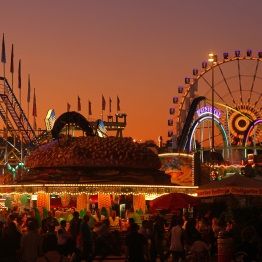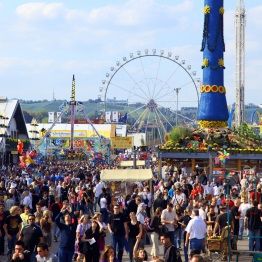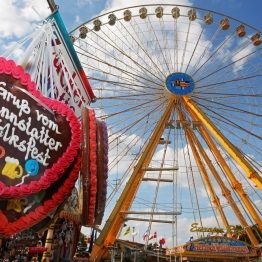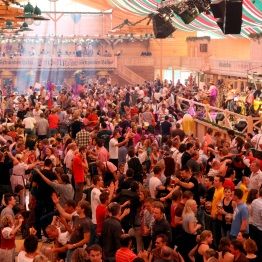The most important facts and figures at a glance? Or do you know when King Wilhelm I of Württemberg and his wife Katharina laid the foundations for what today has become the Cannstatter Volksfest. You will find the answer on this and many other questions here.
in 1818 by King Wilhelm I of Württemberg and his wife Katharina.
17 days
The Cannstatter Wasen is a fairground covering around 25 hectares in the Bad Cannstatt district of Stuttgart. Located directly on the banks of the Neckar, the area is part of the NeckarPark event site, which also includes the MHPArena and the Mercedes-Benz Museum.In addition to the two major public festivals - the Stuttgart Spring Festival and the Cannstatter Volksfest - numerous other events also take place there.
At the beginning of commercial aviation, the site also served as an airfield and zeppelin landing site. At the beginning of the 20th century in particular, the Wasen was the starting point for numerous daring attempts at flight. Local aviation pioneers such as Ernst Heinkel took to the skies with their self-built prototypes. In 1909, an airship finally anchored on the Wasen for the first time. It also played an important role in ballooning. In October 1912, 20 balloons from all over the world took off from here for a race.
Nowadays, the term “Wasen” is also used colloquially as a synonym for the two large public festivals.
Around 300 businesses await visitors.
Thanks to its eight beer tents, the Albdorf, countless beer gardens, snack bars and confectionery stands, the Wasen offers guests a wide range of gastronomic delights.
five kilometres of fun, gastronomic highlights and nostalgia.
about 4 million visitors annually
more than 20,000 Volksfest club members (former German emigrants and their families) from New York, Philadelphia and Chicago regularly visit the Cannstatter Volksfest to affirm and renew their ties of friendship with Stuttgart.
approximately 4,500 people working on the Wasen itself – recruitment of about 300 people by a special on-site job agency.
The Cannstatter Volksfest is a strong economic motor for the city and region. Benefitting from the festival are not the visitors but also bakers, butchers, suppliers, the service industry, the retail trade, hotels, transport companies and lots more businesses. According to a market survey, approximately 17,000 people are directly or indirectly involved in the Cannstatter Volksfest.
100 groups
3,500 participants
300 helpers
250,000 spectators lining the route and about half a million watching on television.





